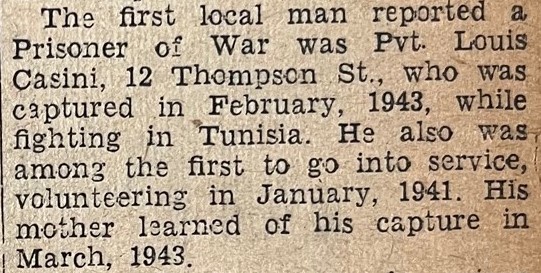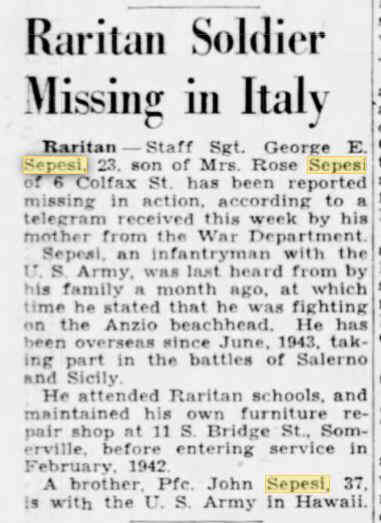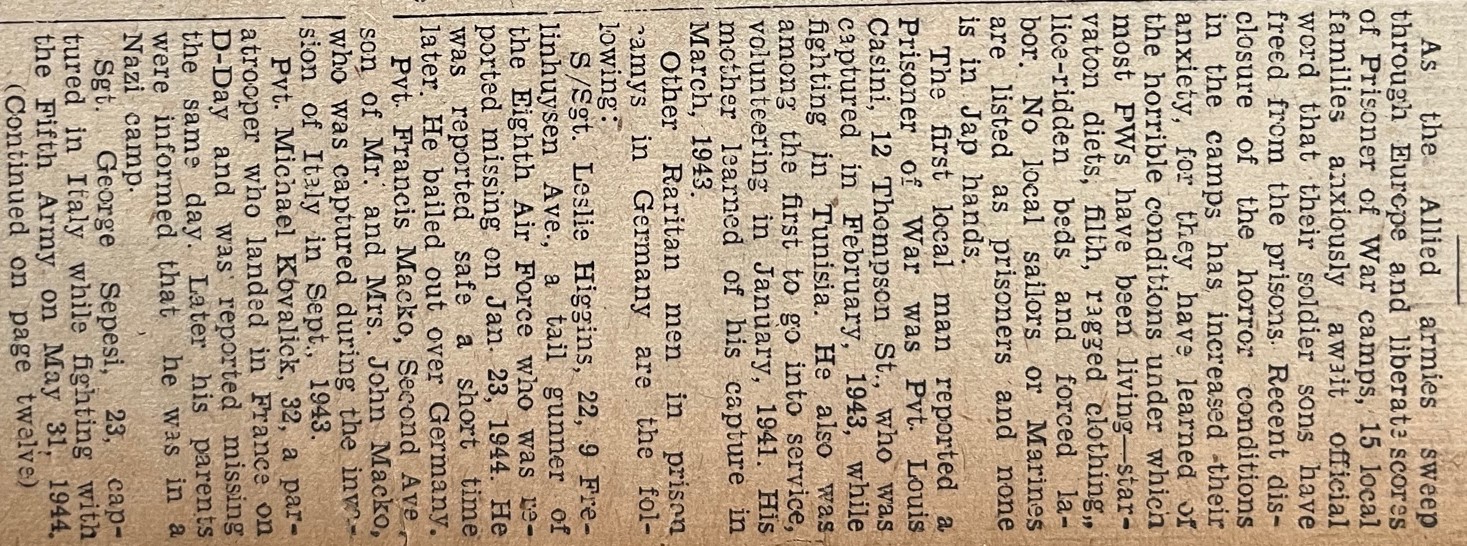
Ironically, while much has been written about Raritan during World War II this was the first time that a list of POWs was done. During World War II eight Raritan men were captured by the Germans and became prisoners. (No Raritan men were prisoners of the Japanese.) In this article we tell a bit about each one of them.

The son of a former U.S. Senator, he was captured in North Africa in 1942 and was assigned to a POW camp in Italy. Inside the POW camp he learned Italian and planned his escape for months. In September of 1943, he made it outside the barbed wire fence of the POW camp and began the more difficult part which was the long dangerous journey back to the U.S troops.
Along the way he received help from the DiGiacomantonio family who risked their lives to aid him. After the war he helped that family immigrate to the United States and settle in Raritan.
Joseph Frelinghuysen documented his fascinating story of escape in the book Passages to Freedom which is today available on Amazon.

After the war he remained in Raritan - working at the Raritan Valley Country Club. He passed away in 1981. His obituary did not mention that he ever married.

After the war he was a supervisor at New Jersey Bell in Newark for 38 years. He was married to Clara Jean Wolferz. They had a son and three daughters. He passed away in 1988.

After the war he married Jennie Jannuzzi and lived in Bound Brook for 41 years before passing away in 1992. They would have one daughter Joan who provided us with a copy of the original telegram that informed his parents of his status as prisoner of war.

After landing they were supposed to group up and establish strongholds around dozens of key positions. However, they were mostly too scattered to achieve anything. But since these paratroopers had been dropped over an area covering hundreds of miles it confused the Germans - as a result the Germans were unable to determine where the main landing would be. No photo, obituary, or additional information could be found on Michael Kovalick. If anyone has any information, please contact me at brucedoorly@gmail.com.

After the war he worked as a woodworker for 43 years. He died in 2004. He and his wife Deborah would have one son Peter who lives in Bridgewater today.

He, along with Reverend Rowland Koskamp, was taken prisoner at the Battle of the Bulge in December of 1944. During that battle when the other troops retreated after they realized that the Germans were overrunning them, Sansone and Koskamp both stayed behind to care for the wounded - setting up an aid station in a basement. Soon the building above them was demolished. Surrounded, the Reverend went out to talk with the Germans explaining that both of them had intentionally stayed behind to care for the wounded - some of which were Germans. He then followed up with a bold request of his enemy, let them go. However, the Germans would have none of it and took them captive immediately. Even a simple request that they be allowed to grab their overcoats was denied.
After the war Joseph Sansone lived in Raritan and worked for 20 years as a heavy equipment mechanic at the Belle Mead Depot and later worked in the local school system. He died in 1994. He and his wife Rose had three daughters and a son. His POW notification telegram survives and can be viewed online.

During his captivity, in March of 1945, his POW camp was briefly liberated when U.S. tanks with troop transports (after traveling a long distance) surprisingly crashed through the prison fence. But their escape was quickly derailed when gasoline supply vehicles did not arrive and most of the vehicles ran out of gas. A few miles outside the POW camp they were stranded, cold, and now disorganized. So most men chose to return to the shelter of the POW camp believing that the Germans had fled for good. However, the Germans soon regained control of the camp and they were prisoners again. To prevent another liberation the Germans marched the prisoners to another more remote camp. During that march U.S. planes accidentally bombed the prisoners - killing many of their own - including Reverend Koskamp.
 |
 |
 |
Other sources were the daily newspaper the Courier News (which is available and searchable online at newspapers.com) and the weekly Somerset Messenger Gazette (which is available on microfilm at the Bridgewater Library). Also, we were able to locate and obtain information from some of the families of prisoners.